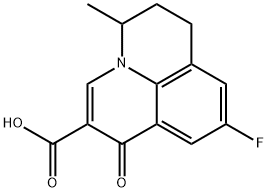
Flumequine
- русский язык имя
- английское имяFlumequine
- CAS №42835-25-6
- CBNumberCB1264632
- ФормулаC14H12FNO3
- мольный вес261.25
- EINECS255-962-6
- номер MDLMFCD00079298
- файл Mol42835-25-6.mol
химическое свойство
| Температура плавления | 253-255°C |
| Температура кипения | 439.7±45.0 °C(Predicted) |
| плотность | 1.45±0.1 g/cm3(Predicted) |
| RTECS | DK1672000 |
| Fp | >110°(230°F) |
| температура хранения | Sealed in dry,Store in freezer, under -20°C |
| растворимость | 1 M NH4OH: soluble50mg/mL |
| пка | pKa 6.42(H2O t=25.0 I=0.025)(Approximate) |
| форма | powder |
| цвет | white to off-white |
| Растворимость в воде | Soluble in DMSO and dilute alkali hydroxides. Insoluble in water |
| Мерк | 14,4137 |
| БРН | 490724 |
| Стабильность | Stable. Incompatible with strong oxidizing agents. |
| Справочник по базе данных CAS | 42835-25-6(CAS DataBase Reference) |
| FDA UNII | UVG8VSP2SJ |
| Код УВД | J01MB07 |
| Система регистрации веществ EPA | 1H,5H-Benzo[ij]quinolizine-2-carboxylic acid, 9-fluoro-6,7-dihydro-5-methyl-1-oxo- (42835-25-6) |
| UNSPSC Code | 41116107 |
| NACRES | NA.24 |
больше
| Коды опасности | Xi | |||||||||
| Заявления о рисках | 36/37/38 | |||||||||
| Заявления о безопасности | 22-24/25-36/37/39-27-26 | |||||||||
| WGK Германия | 3 | |||||||||
| F | 10 | |||||||||
| кода HS | 29339900 | |||||||||
| Банк данных об опасных веществах | 42835-25-6(Hazardous Substances Data) | |||||||||
| NFPA 704: |
|
рисовальное письмо(GHS)
-
рисовальное письмо(GHS)

-
сигнальный язык
предупреждение
-
вредная бумага
H315:При попадании на кожу вызывает раздражение.
H319:При попадании в глаза вызывает выраженное раздражение.
H335:Может вызывать раздражение верхних дыхательных путей.
H302:Вредно при проглатывании.
-
оператор предупредительных мер
P261:Избегать вдыхания пыли/ дыма/ газа/ тумана/ паров/ аэрозолей.
P305+P351+P338:ПРИ ПОПАДАНИИ В ГЛАЗА: Осторожно промыть глаза водой в течение нескольких минут. Снять контактные линзы, если Вы ими пользуетесь и если это легко сделать. Продолжить промывание глаз.
Flumequine химические свойства, назначение, производство
Описание
Flumequine is a synthetic antibiotic belonging to the second-generation quinolone group and is mainly active against Gram negative bacteria. It is currently the only non-humans shared broad-spectrum antimicrobial veterinary drug. It is taken as the substitute product of norfloxacin. It has a strong bactericidal activity with excellent efficacy in the treatment of animal bacterial diseases. Its main effect is to inhibit bacterial deoxy nucleic acid (DNA) gyrase, interfering with the deoxyribonucleic acid (DNA) synthesis, thereby causing failure of cell for further division, and thus playing the role of killing bacteria. It is used in bovine, ovine, chicken, rabbits, goats, horses and salmonidae, however the establishment of MRLs was only requested for non-lactating cattle, pigs, sheep, chicken and salmonidae.Химические свойства
White Crystalline SolidИспользование
Flumequine is a fluoroquinolone compound with antimicrobial activity against Gram-negative organisms. It is used in the treatment of enteric infections in food animals and in the treatment of bacterial infections in farmed fish. Flumequine is replacing oxolinic acid in aquaculture because of its more appropriate pharmacokinetic profile and lower effective doses (Treves-Brown 2000). Flumequine also has limited use in humans for the treatment of urinary tract infections.Фармацевтические приложения
A tricyclic fluorinated 4-quinolone, with activity similar to that of nalidixic acid in vitro, although it is somewhat more active against some Enterobacteriaceae.Following escalating oral doses of 400, 800 or 1200 mg, mean peak plasma levels reached at 2 h are 13.5, 23.8 and 31.9 mg/L, respectively. The apparent elimination half-life is about 7 h. The main metabolite, hydroxyflumequine, is much more rapidly eliminated. About 60% of a dose appears in the urine, mostly in the form of conjugates. Urinary concentrations following an 800 mg dose are 10–35 mg/L, with a peak of 105 mg/L. It has no effect on the pharmacokinetics of theophylline.
Flumequine is generally well tolerated, side effects being mainly mild gastrointestinal tract disturbances, rashes, dizziness and confusion.
It is principally used in uncomplicated urinary tract infections.
Flumequine запасные части и сырье
Flumequine поставщик
| поставщик | телефон | страна | номенклатура продукции | благоприятные условия |
|---|---|---|---|---|
| +8615531157085 | China | 8804 | 58 | |
| +86 13288715578 +8613288715578 |
China | 12825 | 58 | |
| +86-18031140164 +86-19933155420 |
China | 100 | 58 | |
| +86-13131129325 | China | 5887 | 58 | |
| +8613343047651 | China | 3692 | 58 | |
| +8615373025980 | China | 895 | 58 | |
| +86-18503288844 +86-18503288844 |
China | 420 | 58 | |
| +86-0371-55170693 +86-19937530512 |
China | 21632 | 55 | |
| +8615102730682 | CHINA | 566 | 55 | |
| +86-0371-86658258 +8613203830695 |
China | 29871 | 58 |